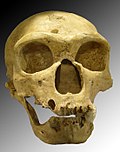| Present-day country (country of discovery) |
Site |
Principal Neanderthal finds |
MNI |
Geological age (ka) |
Descriptions |
Notes |
| Turkey |
Karain |
Four teeth |
1 |
— |
Senyürek (1949)[4][5]
Yalçınkaya (1988)[6][5] |
|
| Lebanon |
Ksâr 'Akil |
K2: Teeth and partial maxilla |
1 |
— |
Ewing (1963)[7] |
Ewing lost this specimen while transferring Ksar Akil material from Boston College to Fordham University.[8] |
| Lebanon |
El Masloukh |
Upper second molar[9] |
(1) |
— |
? |
Neanderthal attribution is stratigraphic, not morphological.[10] |
| Israel |
Kebara |
KMH1: 7-9 mo. old partial skel.
KMH2: Post-cranial adult ♂
Various fragments
KMH3: Milk tooth (m1-r)[11]
KMH4: 9 milk teeth, germ of 1 permanent tooth [12][11]
KMH5: Child mandibular symphysis fragment, no teeth[11]
KMH6: Right maxillary fragment with M1 and M2[11]
KMH7: Milk tooth (m?-r)[11]
KMH8: Milk tooth (m2-l)[11]
KMH9: Foot bone (4th right metatarsal)[11]
KMH10: Foot bone (1st toe distal phalanx)[11]
KMH11: Right clavicle fragment[11]
KMH12: Milk tooth (m?-r)[11]
KMH13: Milk tooth germ (m1-l)[11]
KMH14: Tooth (M2-l)[11]
KMH15: Milk tooth (m1-r)[11]
KMH16: Milk tooth (left i1)[11]
KMH17: Clavicle fragment[11]
(KMH18: Mandibular fragment with tooth [M2-r])[11]
(KMH19: Fragmentary tooth crown [M?-r])[11]
(KMH20: Parietal bone fragment)[11]
(KMH21: Germ of tooth [M1-l])[11]
(KMH22: Milk tooth [upper c-l])[11]
(KMH23: Milk tooth [i2-r])[11]
KMH24: Tooth (M3-l)[11]
(KMH25: 3 milk teeth germs [upper c-l, m1, m2])[11]
(KMH26: Tooth germ [i2-r])[11]
KMH27: Tooth (I2)[13][13]
KMH28: Tooth (I2)[13][13]
(KMH29: Milk tooth [i2-l])[11]
KMH30: Milk tooth (m1)[11][13]
(KMH31: Tooth [lower c])[13]
|
21 + (10) |
64-59[14][15] |
KMH1: Smith et al. (1977)[16]
KMH2: Arensburg et al. (1985)[17]
KMH5-17, 24-31 : Tillier et al. (2003) [11] |
Neanderthal attribution uncertain in KMH18-23, 25, 29, and 31[11][13] |
| West Bank (Mandatory Palestine) |
Shuqba |
S-D1: Tooth and cranial frags.[9] |
1 |
— |
Keith (1931)[18] |
|
| Israel (Mandatory Palestine) |
Tabun |
T C1: Nearly complete adult ♀
T C2: Toothed mandible missing I1 (♂)
Various fragments
T E1: Right femur shaft (♂?)
T E2: Tooth (M1 or M2, ♀?)
T C3: Right femur shaft (♀)
T C4: Distal right radius frag. (♀)
T C5: Right hamate bone
T C6: Right pisiform bone
T C7: Distal thumb phalanx
T B1: 10-11 year-old maxilla (♂?) with I2-r, M2-r
T BC2: Four teeth
(I2-l, M1-l, P3-r, M1-r)
T B3: One tooth (I2-r)
T B4: Four teeth
(I1-l, I2-l, M1-l, M3-r)
T B5: Two teeth (M2-l, M2-r)
T BC6: Two teeth (I1-l, M2-l)
|
15 |
≈170-90
[19][20][21] |
McCown (1936)
McCown and Keith (1939) |
T C1: Neanderthal attribution is not universally accepted.[22]
As of 1975, the whereabouts of T BC2, B3, and BC6 are unknown.[9]: 146 |
| Israel |
Ein Qashish |
(EQH-2: Third molar)
EQH-3: Adult lower limbs |
1 + (1)[23] |
70-60[23] |
Been et al. (2017)[23] |
Discovered in 2013, these were the first diagnostically Neanderthal remains in Southwest Asia not found in a cave.[23]
EQH-2: 70% posterior probability that Neanderthal attribution is correct.[23] |
| Israel |
Shovakh |
(Tooth, M(3)-l[24][Note 1]) |
(1) |
— |
S. Binford (1966)[25]
Trinkaus (1987)[24]
|
"[A]lthough within archaic and modern human ranges of variation, this complex occlusal morphology may suggest that it is more likely to have derived from a Neandertal than an early modern human". (Trinkaus 1987)[24] |
| Israel |
Amud |
A1: Adult full skeleton ♂
A2: Maxillary fragment
A7: 10-mo.-old partial skel. |
3[Note 2][26] |
61-53[26] |
A1: Suzuki et al. (1970)[27]
A7: Rak et al. (1994)[28] |
|
| Syria |
Dederiyeh |
D1: 19-30-month-old full skel.
D2: 21-30-month-old full skel. |
17 |
— |
D1: Akazawa et al. (1993)[29]
D2: Akazawa et al. (1999) [30] |
|
| Iraq |
Shanidar |
S1: Adult partial skel. ♂
S2: Adult crushed skel. ♂
S3: Post-cranial adult ♂
S4: Adult partial skel. (♂)
S5: Adult partial skel. (♂)
S6: Adult partial skel. (♀)
S7: 6-9-mo.-old crushed skel.
S8: Adult skeletal fragments (♀)
S9: 6-12-month-old vertebrae
S10: 17-25-month-old skel. |
10 |
S2, S4: > 100
Others: 60 |
S1: Stewart (1959)[31]
S2: Stewart (1961)[32]
S3: Solecki (1960)[33]
S4: Stewart (1963)[34]
S5: Trinkaus (1977)[35]
Pomeroy et al. (2017)[36]
S6: Same as S4
S7: Senyürek (1957)[37][38]
S8: Same as S4
S9: ?
S10: Cowgill et al. (2007)[39]
|
Shanidar 2 and 4 are sometimes not treated as Neanderthals.
All but Shanidar 3 and 10 (and fragments of 5 excavated in 2015-2016)[36] may have been destroyed in the 2003 invasion of Iraq.[40] |
| Iran |
Bawa Yawan |
Lower left deciduous canine |
1 |
~43,600-~41,500 years ago[41] |
Heydari-Guran et al (2021)[41] |
| Iran |
Wezmeh |
maxillary right premolar tooth |
1 |
70-40[42] |
Zanolli et al. (2019)[42] |
| Iran |
Bisitun |
Adult radius shaft |
1 |
— |
Trinkaus and Biglari (2006)[43] |
|
| Total |
|
|
71 + (13) |
|
|
|






